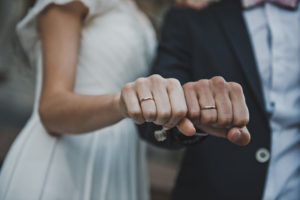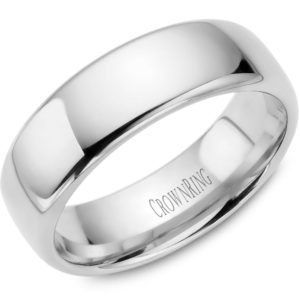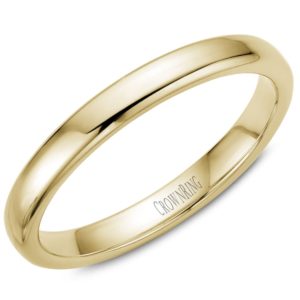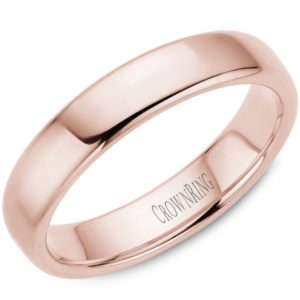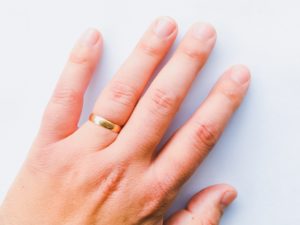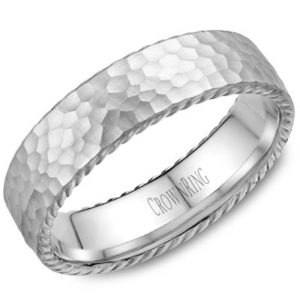The expert guide to picking the perfect wedding band.
Men’s wedding bands have only recently been cast into a bigger spotlight. Until now, the wedding ring hype surrounded the bride, seemingly leaving grooms out of the fun; but not anymore! We’ve noticed men’s wedding band styles changing drastically to include a variety of metals and designs!
The groom’s band used to be chosen simply to match the bride-to-be’s ring, but, the band is so much more than just a matching accessory. The groom will wear this band almost every single day for the rest of his life and it is meant to symbolize the lifelong commitment being made. So, it’s only right that just as much time is spent making sure the groom has the perfect band.
Men are starting to care a lot more about their wedding band and how it is styled, and we don’t blame them! With all the new styles and an abundance of choice coming out in the industry, it can be difficult now to narrow all the options down to a single choice.
So, if you’re engaged or considering a proposal, here are a few things to keep in mind while you search for your wedding band!
-
Pick Your Metal
Deciding on which type of metal (or a combination) you prefer your wedding band to be made of will help to drastically narrow down your search. Here is a list of the metals that are most commonly used in wedding bands:
- Platinum: platinum is white/silver in colour and is more expensive than gold due to its rarity and the advanced skill required to properly work with it. This metal is extremely durable which is what makes it a perfect choice for a band that will face everyday wear. Platinum is also a great hypoallergenic option for anyone with skin sensitivities. Over time, platinum will wear down to a dark grey colour but can be polished back to its original colour as needed.
- White Gold: similar in appearance to platinum, white gold is an alloy made of pure gold mixed with other white metals such as nickel or silver. Due to its long-term durability and affordable price, white gold is by far the most popular pick for men’s wedding bands! It actually has a natural slight yellow colour, so it is plated with rhodium to give it the bright white colour you see. The brightness does slowly wear down over the years, but you can bring your ring into your jeweller as required for a polish or re-plating.
- Yellow Gold: everyone is familiar with the classic yellow gold, but what most people don’t know is that yellow gold rings are very rarely pure gold. Most wedding bands made of yellow gold will have another metal mixed in for stability. The ratio of pure gold to the metal that is mixed in is what makes determines the karats; for example, 18 karat gold has a higher ratio of pure gold but is much softer and prone to scratching. 10 karat gold is the strongest as it has less soft pure gold and a higher ratio of mixed metal in the alloy.
- Rose Gold: rose gold can appear anywhere from red to light pink; its’ colour depends on the amount of copper that is mixed with the gold to create the rose appearance.
- Sterling Silver: sterling silver is silver in colour (obviously) and is much cheaper than other metal types due to the abundance of it. Sterling Silver is silver mixed with copper or another metal to make it more durable. Sometimes the colour of the silver can dull over time, but regular polishes will keep that from happening! Sterling Silver is a wallet-friendly option but isn’t recommended for long-term wear as it is a very soft metal. This does make Sterling Silver a great option when travelling; swap out your expensive band for a Silver one and travel worry-free!
In addition to these precious metals that are commonly used in wedding bands, there have been recent trends of other (cheaper) materials being used in wedding bands, such as:
- Tungsten
- Titanium
- Silicone
- Wood
2. Choose Your Fit
After selecting your metal, you should make yourself familiar with the size and fit you’d like for your wedding band. While you are shopping, customer service representatives will ask you for your fit in every store, so it is best to get fitted at the beginning of your search.
The most effective way to ensure you get the right fit the first time (and therefore avoid the hassle of needing your ring to be re-sized) is to get sized in person by a professional jeweller. We suggest heading into a smaller jewellery shop (like Edwards&Davies!) and dealing with a professional jeweller who has experience sizing rings rather than a sales clerk in a larger shop or department store.
Once you’ve landed on your ring size, decide if you prefer standard or comfort fit. Standard fit rings are flat on the inside while comfort fit rings are rounded, conforming to your finger a bit more. Try a ring in your size on in both fits and decide which you prefer.
3. Select Your Style
While the material and fit of your wedding band are integral to choosing the right ring, you also need to find a style that you connect with on a personal level. When you’re looking for a wedding band, try to think of design aspects that represent your personality and who you are. As you’re looking at a variety of styles, pay attention to the bands that stick out and speak to you.
If you are a simple dresser, perhaps a businessman or in other ways consider yourself to be sophisticated, there is no storage of no-frills, understated wedding bands available on the market.
At the same time, if you are more outspoken, a trend-follower, or love experimenting with your style, perhaps a more detailed or textured wedding band is up your alley.
Whatever your style is, these 3 simple steps will help you get started on your journey to selecting your perfect wedding band!


